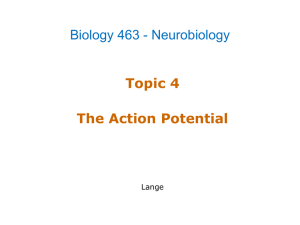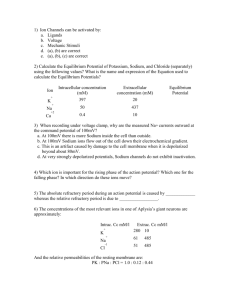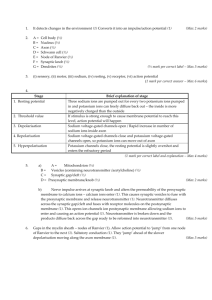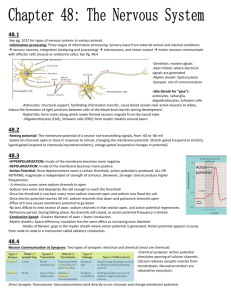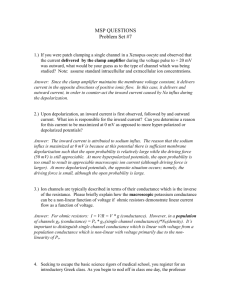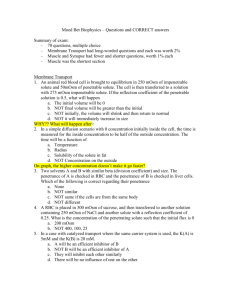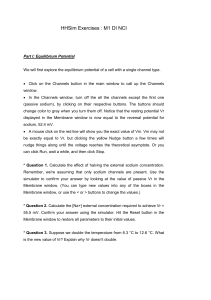BioPhysics(more)2005
advertisement
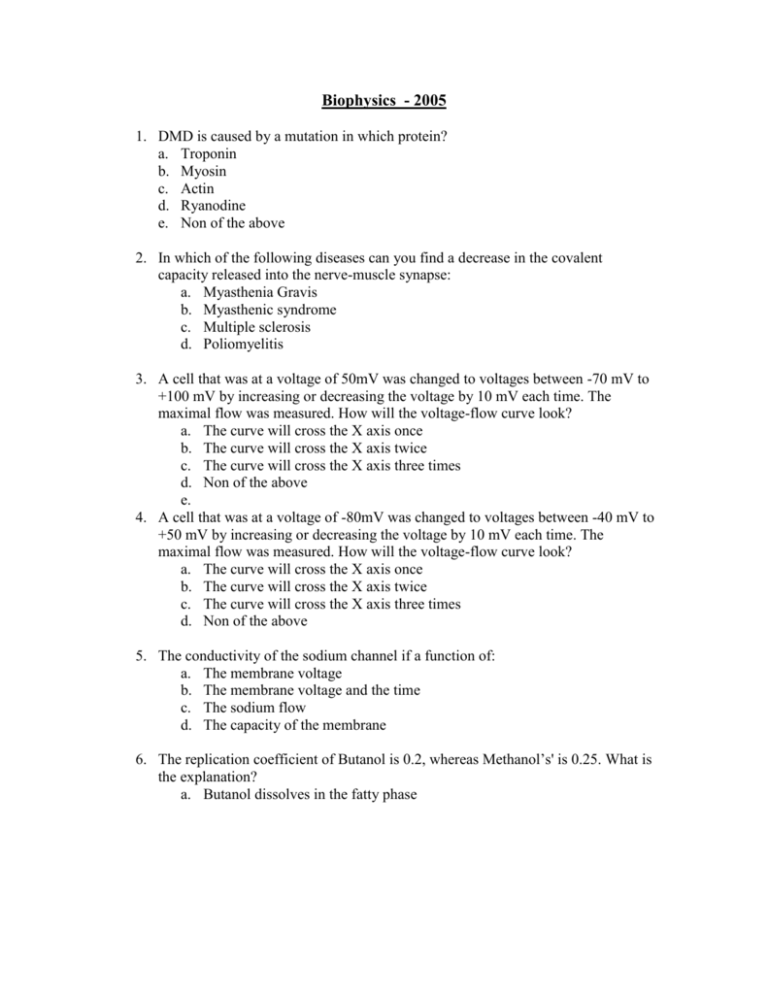
Biophysics - 2005 1. DMD is caused by a mutation in which protein? a. Troponin b. Myosin c. Actin d. Ryanodine e. Non of the above 2. In which of the following diseases can you find a decrease in the covalent capacity released into the nerve-muscle synapse: a. Myasthenia Gravis b. Myasthenic syndrome c. Multiple sclerosis d. Poliomyelitis 3. A cell that was at a voltage of 50mV was changed to voltages between -70 mV to +100 mV by increasing or decreasing the voltage by 10 mV each time. The maximal flow was measured. How will the voltage-flow curve look? a. The curve will cross the X axis once b. The curve will cross the X axis twice c. The curve will cross the X axis three times d. Non of the above e. 4. A cell that was at a voltage of -80mV was changed to voltages between -40 mV to +50 mV by increasing or decreasing the voltage by 10 mV each time. The maximal flow was measured. How will the voltage-flow curve look? a. The curve will cross the X axis once b. The curve will cross the X axis twice c. The curve will cross the X axis three times d. Non of the above 5. The conductivity of the sodium channel if a function of: a. The membrane voltage b. The membrane voltage and the time c. The sodium flow d. The capacity of the membrane 6. The replication coefficient of Butanol is 0.2, whereas Methanol’s' is 0.25. What is the explanation? a. Butanol dissolves in the fatty phase 7. An increase of GABA in the post synaptic cell will cause: a. A higher probability of opening the post synaptic chlorine channel b. A higher probability of opening the post synaptic sodium channel c. An increase is the membrane capacity d. An increase in the membrane resistance e. Enlargement of the post synaptic membrane f. A decrease of the time coefficient g. a+f h. All of the above i. c+d 8. In order to measure a change in voltage of the action potential, we should use a cell: a. In a dry environment without water b. In an environment without sodium c. During voltage clamp d. Non of the above 9. Why is the sum of synapses in time and space sub-linear ? a. Because of a decrease un the driving force b. Due to inactivation of channels 10. A scientist took two solutions, one with 0.1M NaCl and the second with 0.01M NaCl, so that Pna=100PCl and but a biological membrane between them. At t=0 he added substance X that changed sodium conductivity, so that PNa=0.01PCl. What will happen to the membrane potential? a. Nernst potential of potassium increases and the potential of sodium decreases. b. The membrane potential doesn't change c. The membrane voltage levels at zero d. The equilibrium potential of sodium and potassium doesn't change 11. Given a 2µ Myosin fiber and a 1µ Actin fiber, what is the length that we will not see a contraction? 8.4µ. 1.4µ 1.1µ 8.2µ a. 4.8µ only b. 4.8µ and 1.5µ c. 2.µµ only d. 4.8µ and 1.8µ and 1.5µ| e. All of the above 12. What should we expect to see in a transgenic mouse with only white muscle fibers? a. He will be able to run faster b. He will need to use fat reserves c. He will consume more energy d. a+c e. a+b f. He will be able to fun for a longer period of time 13. A scientist put Actin and Myosin fibers in a test tube. What is needed for them to bind? a. ATP b. Ca+2 c. Myosin d. Troponin e. Tropomyosin f. a+b g. All of the above 14. The action potential requires interactions between: a. Calcium and Sodium flow b. Potassium and Sodium flow c. Conductivity of Potassium and Sodium d. Stimulating and restraining forces 15. The osmolarity of a solution of solute X is 300mOs. The freezing point of the solution is 0.45C lower than that of purified water. What is the reason? a. The replication coefficient of the solute is smaller than 1 b. The solute absorbs water molecules c. The solute does not completely separate into ions d. The solute turns into dimmers 16. What problem will transgenic mice lacking the protein Snap-25 have? a. A problem docking to the presynaptic membrane b. A problem connecting to the cytoskeleton of the synaptic terminal c. A problem recycling vesicles. 17. After destructing the metabolic activity and the ATP in a red blood cell, how Will we be able to affect the Potassium flux out of the cell? a. Quabain b. Cooling c. Adding Choline instead of Sodium d. Non of the above 18. What will be the effect of LTP? a. A higher amplitude of the EPSP b. A longer synaptic response c. A longer action potential 19. What is the definition of a retrograde messenger? a. A transmitter secreted by the postsynaptic cell that effects the presynaptic cell. b. A transmitter that causes hyperpolarazation 20. During the action potential the sum of all currents is: a. Zero b. Inward c. Outward d. Non of the above – it depends on the direction of the cell 21. Red blood cell were taken out of a solution of 300mOs NaCl and placed in a solution that made them shrink and then return to there original size. Mark the correct answer: a. The solution contained only penetrating solutes b. The solution contained both penetrating and non penetrating solutes. c. The solution contained only non penetrating solutes 22. Substance A and substance B have the same polarity and both have the same molecular weight. A is a long chain, and B is spherical. Which has a higher diffusion coefficient? a. A b. B c. The answer can not be determined. 23. According to the Hodjkin and Huxley model: a. There is a direct connection between inactivation and channel opening b. There is no direct connection between inactivation and channel opening c. There is no activation process d. The inactivation does not depend on the membrane charge 24. In Barters' disease the patient suffers from hypocalemia (lack of Potassium) and lack of protons. What is the main mechanism of the disease? a. Decreased function of the Na/K ATPase b. Decreased reabsorption of NaCl from the nephron lumen c. Decreased penetration of K+/H+ into the cells 25. In sickle cell anemia, what is the main mechanism causing dehydration? a. Spontaneous activity of the Gardos channels b.Increase in the cell permeability to calcium c. Increase in the Acidity d.Spontaneous activity of KCC 26. A scientist took red blood cells and put them in different penetrating substances. How can you distinguish between them? a. According to the degree of hemolysis b.According to the final cell size c. According to the minimal cell size d.According to the hemolysis rate 27. A lack in which protein will not cause muscle weakness? a. Actin b.Myosin c. Tropomyosin d. Myoglobin e. Troponin
